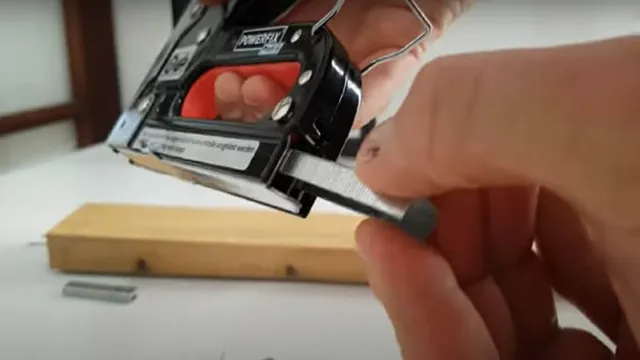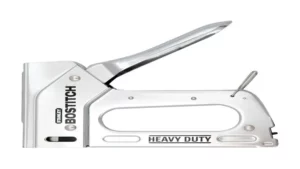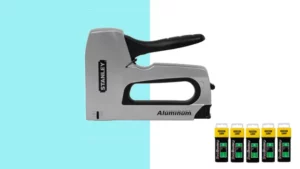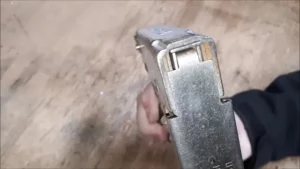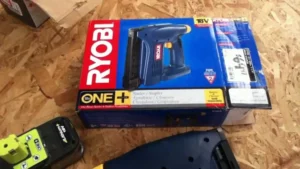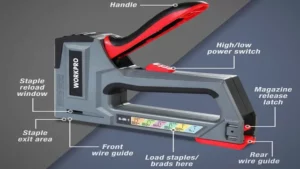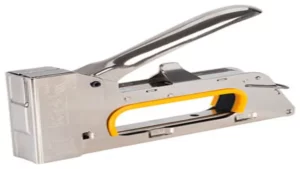Staple guns are an essential tool for DIY enthusiasts, carpenters, and crafters alike. However, understanding their different mechanisms and knowing how to adjust them can be overwhelming for a beginner. Whether you’re looking to secure fabric, wood, or even wiring, knowing how to adjust a staple gun is crucial.
In this beginner’s guide, we’ll take you through the basics of staple guns, how to adjust them based on your needs, and ensure that you’re confident and safe with this useful tool. So, grab your staple gun and let’s dive into the world of adjustment!
Introduction
If you want to make sure that your staple gun is working at its best, you’ll need to know how to adjust it. Even though the process may seem intimidating at first, it’s really not that difficult. The first thing you’ll need to do is find the adjustment knob on your staple gun.
This will be either on the top or the bottom of the tool, and it will allow you to adjust the depth of the staples that your gun fires. Once you’ve found the adjustment knob, you can start making adjustments by turning it one way or the other. If you need to increase the depth, turn the knob clockwise.
If you need to decrease the depth, turn it counterclockwise. It’s as simple as that! With a little bit of practice, you’ll be able to adjust your staple gun like a pro and get the perfect results every time you use it.
What is a staple gun and how does it work?
Staple guns are a very useful and common tool that you may have seen or used before. Essentially, a staple gun is a handheld device that is used to drive staples into a material, such as wood, paper, or fabric. Staple guns come in varying sizes and styles, from small manual guns to larger automatic guns, but they all work in a similar way.
When the trigger of the staple gun is squeezed, a spring-loaded mechanism releases a staple that is driven into the material using a sharp metal point. The staple gun can be used for a variety of different tasks, such as attaching fabric to a frame, securing thin pieces of wood, or even for arts and crafts projects. With a staple gun, you can easily and quickly complete projects that would otherwise be difficult or time-consuming to do by hand.
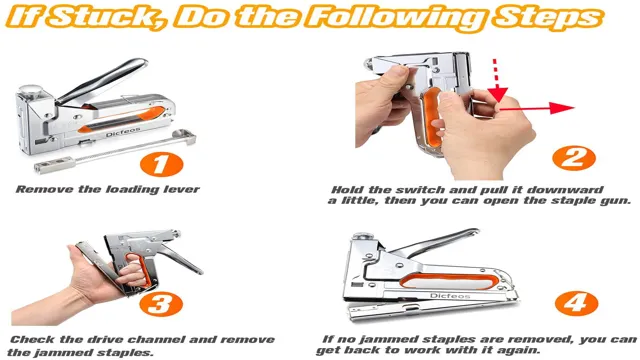
Step-by-Step Guide
If you’re working on a DIY project that involves stapling, you may need to adjust your staple gun to ensure smooth and precise operation. Fortunately, adjusting a staple gun is a fairly simple process that just about anyone can handle. First, make sure your staple gun is empty and disconnected from any power source.
Then, locate the adjustment mechanism, which is usually located on the bottom or rear of the gun. Using a screwdriver or similar tool, adjust the mechanism to the desired depth or width setting. Be sure to test the staple gun on a scrap piece of material to ensure it’s working properly before using it on your project.
And there you go – with just a few simple steps, you can adjust your staple gun like a pro and get back to your project in no time!
Step 1: Determine the type of staple gun you have
Staple gun If you own a staple gun, the first step in using it effectively is to determine the type of staple gun you have. This may seem like a no-brainer, but it’s an important step that can save you time and frustration in the long run. There are three main types of staple guns: manual, electric, and pneumatic.
Manual staple guns require physical force to drive the staple into the material, while electric staple guns use electricity to do the work for you. Pneumatic staple guns are powered by compressed air and are typically used for heavy-duty projects. Once you’ve determined the type of staple gun you have, you can proceed with the appropriate steps for loading and using it.
Don’t skip this crucial first step, as it can make a big difference in ensuring that your stapling projects go smoothly.
Step 2: Loosen the tension knob
Loosening the tension knob is the next step in successfully adjusting the tension of your sewing machine. This knob, usually located on the upper right-hand side of the machine, is responsible for controlling the amount of tension applied to your thread as it passes through the machine. Before attempting to adjust the tension, it’s important to loosen the knob to avoid damaging the machine or the thread.
To do this, turn the tension knob counterclockwise until it stops, and then give it a slight nudge further to fully loosen it. Once the knob is loose, you can then proceed to adjust the tension according to the type of fabric you’re working with. Remember to always refer to your machine’s manual for specific instructions on adjusting the tension, and don’t be afraid to experiment with different settings until you find the perfect one for your project.
By taking this crucial second step in the process, you’ll be well on your way to creating beautiful and professional-looking sewing projects!
Step 3: Adjust the depth control
To optimize your cutting performance, it’s essential to adjust the depth control of your saw. This step allows you to set the exact depth of the blade to match the thickness of the material you’re cutting. You can adjust the depth control by referring to the measurement scale on the saw or by using a depth gauge.
To start, loosen the depth adjustment knob, place the blade over the material, and adjust the depth control until the blade’s teeth are just below the surface of the material. Make sure to secure the depth adjustment knob once you’ve determined the appropriate depth. This step is essential to ensure precise and accurate cuts.
By adjusting the depth control of your saw, you can achieve cleaner and smoother cuts every time. Keep in mind that proper adjustments increase the tool’s performance while reducing the risk of damage or injury.
Step 4: Tighten the tension knob
As you near the end of setting up your spin bike, it’s important to make sure the tension knob is tightened properly. This knob is responsible for regulating the resistance on your bike, and having it set to the right amount can make all the difference in your workout experience. To tighten the knob, simply turn it clockwise.
But be careful not to over-tighten it, as this can put unnecessary strain on the bike’s mechanisms. It’s best to find a balance where the knob is secure, but not so tight that it’s difficult to adjust during your workout. Once you’ve found the sweet spot, you’re ready to hop on and start spinning! And with this final step complete, you can rest easy knowing your bike is set up properly and ready to provide you with a great cardio workout.
Step 5: Test the staple gun
Now that you have properly loaded the staple gun, it is time to test it out. Testing the staple gun beforehand can save you from any inconvenience later on. To test your staple gun, attach it to a scrap piece of wood or cardboard.
Make sure the staple gun is properly aligned, and then gently squeeze the trigger to ensure the staple punctures the material. You can also test the depth of the staple by adjusting the pressure settings of the staple gun. If the staple gun is not putting enough pressure, you can adjust the pressure by turning the knob on the back of the stapler.
Conversely, if the staple gun is putting too much pressure, you can adjust the pressure by turning the knob in the opposite direction. Ensure that you test the staple gun multiple times before using it on your actual task to make sure it is working correctly. By taking the time to test your staple gun, you can save valuable time and effort in the long run.
Remember, it’s always better to be safe than sorry!
Important Tips
Adjusting a staple gun is an essential task if you want to make sure that your projects align with accuracy. Before attempting any adjustments, it is important to consult with the manufacturer’s guide to ensure that you are handling the right type of staple gun. Remember to wear sturdy gloves and safety glasses to ensure protection while adjusting.
To adjust a staple gun, start by using a flat head screwdriver to loosen the small screw located near the trigger. Next, move the metal contact to the position that you believe will be ideal for your project and then use the same screwdriver to tighten the screw again. Ensure that the setting is tight and secure.
Finally, test your staple gun using a scrap piece of lumber or cardboard. If your staple gun is still not working properly, you may need to adjust the power level or change the staples you’re using. With these important tips, you can easily adjust your staple gun and get your next project done in no time.
Wear appropriate safety gear
“Appropriate Safety Gear” When it comes to any activity or task that involves potential risks or hazards, wearing appropriate safety gear is always necessary. This gear could include hardhats, gloves, steel-toed boots, safety glasses, or anything else that is meant to protect your body from harm. Without proper safety gear, you could face serious injuries, permanent damage, or even death.
When selecting the appropriate gear, always ensure that it is comfortable, fits properly, and is durable enough to withstand the task at hand. Additionally, make sure to check that your gear is up-to-date and designed for the specific activity you will be undertaking. It’s important to never cut corners when it comes to safety gear; after all, you only have one body, and it’s worth protecting with the right gear.
Keep the staple gun clean and well-maintained
One of the most important aspects of using a staple gun is keeping it clean and well-maintained. This will not only ensure that the staple gun remains in good working condition, but it will also prolong its lifespan. To keep your staple gun clean, start by removing any dust or debris that may have accumulated on it.
This can be done using a dry cloth or a soft-bristled brush. Next, inspect the staple gun for any signs of wear or damage. If you notice any broken or missing parts, it’s important to replace them as soon as possible.
Additionally, be sure to lubricate the moving parts of the staple gun regularly to keep it operating smoothly. By following these important tips, you can make sure that your staple gun remains in top condition for years to come.
Use the right staples for the job
When it comes to stapling, it’s important to use the right type of staple for the job at hand. Not all staples are created equal and different projects require different types of staples. For example, using heavy-duty staples when stapling through multiple pages is crucial in order to ensure that they are bound together securely.
On the other hand, if you’re working with delicate materials like fabric, using a light-duty staple is necessary to avoid damaging the material. One more thing to keep in mind is the size of the staples you use. Using the wrong size can result in a staple that’s too loose or too tight, which can affect the strength of your binding.
So, always make sure you’re using the right staple for the job. By doing so, you’ll achieve a professional and clean end result that will last for years to come.
Conclusion
Adjusting a staple gun may seem daunting at first, but with patience and a few simple steps, you’ll be shooting staples like a pro. Remember to always make necessary adjustments before using your staple gun to ensure maximum efficiency and accuracy. And just like a tailor hemming a pair of pants, finding the perfect fit for your staple gun will make all the difference in the end.
So, go forth and staple on, my friends!”
FAQs
What are the common reasons why a staple gun misfires?
A staple gun may misfire due to various reasons such as worn-out or damaged parts, jammed magazine, debris or foreign objects blocking the stapling mechanism, wrong staple size, or low air pressure.
How do I adjust the depth of the staple gun?
To adjust the depth of a staple gun, check your user manual for instructions on how to adjust the pressure or depth control knob or screw. Some models may require you to adjust the air pressure or change the length of the driver blade.
Can I use different types of staples with my staple gun?
It depends on the model of your staple gun. Some staple guns are designed to use specific types or sizes of staples, while others can accommodate multiple staple sizes and types. Check your user manual or contact the manufacturer to ensure that the staples you plan to use are compatible.
How do I prevent jamming in my staple gun?
To prevent jamming in your staple gun, regularly clean and lubricate the tool, use staples of the correct size and type, and avoid overloading the magazine. Also, avoid using bent or damaged staples and ensure that the stapling mechanism is clear of debris or foreign objects.
Why is my staple gun not firing?
A staple gun may fail to fire due to low air pressure, damaged or worn-out parts, jammed magazine, or the wrong staple size. Check your user manual for troubleshooting steps or contact the manufacturer for assistance.
How do I maintain my staple gun?
To maintain your staple gun, regularly clean and oil the tool, replace worn-out or damaged parts, store in a dry place, and use only the recommended staples. Follow the manufacturer’s maintenance instructions to ensure that your staple gun stays in good working condition.
Can I use my staple gun with different materials?
It depends on the type of staple gun and the material. Some staple guns are designed for specific materials such as wood or fabric, while others can handle a variety of materials. Check your user manual or contact the manufacturer to ensure that your staple gun is suitable for the intended material.
